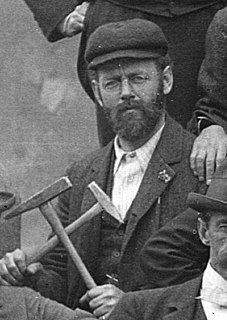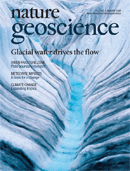
The Geological Society of America (GSA) is a nonprofit organization dedicated to the advancement of the geosciences.

Grove Karl Gilbert, known by the abbreviated name G. K. Gilbert in academic literature, was an American geologist.
Allan Verne Cox was an American geophysicist. His work on dating geomagnetic reversals, with Richard Doell and Brent Dalrymple, made a major contribution to the theory of plate tectonics. Allan Cox won numerous awards, including the prestigious Vetlesen Prize, and was the president of the American Geophysical Union. He was the author of over a hundred scientific papers, and the author or editor of two books on plate tectonics. On January 27, 1987, Cox died in an apparent suicide.
Dr. Walter Hermann Bucher was a German-American geologist and paleontologist.

James Furman Kemp, Sc.D., LL.D was an American geologist.

Charles David White, who normally went by his middle name, was an American geologist, born in Palmyra, New York.
Ethnogeology is the study of how geological features were understood by ancient peoples around the globe from a "place-based" perspective, in specific reference to traditional knowledge and to the stories and ideas about the Earth that were passed down through traditions and the wisdom of elders. The focus in past research tended to be on the unique ideas and knowledge of minorities and distinct cultural groups, and how this relates to universal and cross cultural knowledge discovered by humanity as a whole. Knowledge claims that are based more on universal discoveries and natural science can be found in the subjects of philosophy, chemistry, physics, biology, mathematics, and geology. The term "ethnogeology" first enters the geological literature through the work of John Murray of the University of Manitoba in Winnipeg, Canada in the mid-1990s by virtue of his studies of the Northern Cree First Nation geological worldviews in the Province of Manitoba in Canada. At that time, a cadre of geologists and geoscience educators - particularly Dr. Steven Semken of Navajo Community College in Shiprock, New Mexico and colleagues - were examining the interesting connections among Native American traditional knowledge, geoscience concepts, and the unique vision of planet Earth's history as articulated by indigenous ethnogeological wisdom.

Geology is a peer-reviewed publication of the Geological Society of America (GSA). GSA says that it is the most widely read scientific journal in the field of earth science. It is published monthly, with each issue containing 20 or more articles. The journal impact factor of Geology was 4.842 in 2018/2019, which has declined about 10% over the last five years.

A clastic dike is a seam of sedimentary material that fills an open fracture in and cuts across sedimentary rock strata or layering in other rock types. Clastic dikes form rapidly by fluidized injection or passively by water, wind, and gravity. Diagenesis may play a role in the formation of some dikes. Clastic dikes are commonly vertical or near-vertical. Centimeter-scale widths are common, but thicknesses range from millimetres to metres. Length is usually many times width.
Women in geology concerns the history and contributions of women to the field of geology. There has been a long history of women in the field, but they have tended to be under-represented. In the era before the eighteenth century, science and geological science had not been as formalized as they would become later. Hence early geologists tended to be informal observers and collectors, whether they were male or female. Notable examples of this period include Hildegard of Bingen who wrote works concerning stones and Barbara Uthmann who supervised her husband's mining operations after his death. Mrs. Uthmann was also a relative of Georg Agricola. In addition to these names varied aristocratic women had scientific collections of rocks or minerals.
Burrell Clark Burchfiel is an American structural geologist. Born in Stockton, California, he earned his Ph.D. in 1961 at Yale University. His first academic appointment was to the Geology department at Rice University. He is the Schlumberger Professor Emeritus of Geology at MIT. Research interests: Origin, development, and structural evolution of the continental crust. His current work involves study of the geological history and evolution of the Tibetan plateau.
The Geological Society of Australia (GSA) was established as a non-profit organisation in 1952 to promote, advance and support earth sciences in Australia. The founding Chairperson was Edwin Sherbon Hills.

Nature Geoscience is a monthly peer-reviewed scientific journal published by the Nature Publishing Group. The Chief Editor is Tamara Goldin, who took over from Heike Langenberg in February 2020. It was established in January 2008.

Thomas Brennan Nolan was an American geologist who was director of the United States Geological Survey (USGS) from 1956 to 1965. The mineral nolanite is named in his honor. He was generally known as Tom Nolan.

Arnold Hague was a United States geologist who did many geological surveys in the U.S., of which the best known was that for Yellowstone National Park. He also had assignments in China and Guatemala. He became a member of the U. S. Geological Survey in 1879 when it was first organized.

Samuel Calvin was Iowa's first systematic geologist, helping to make the first bedrock and landform maps of Iowa, as well as leading geological research throughout the state. He was born in Scotland, attended Lenox College in Hopkinton, Iowa, where he later taught. One of his collaborators was Thomas Huston Macbride, the notable Iowa naturalist. Calvin became a University of Iowa professor in 1873 and the Iowa State Geologist in 1892, and led the Iowa Geological Survey from 1892 until his death. Calvin documented the Devonian and Aftonian beds of Iowa, and was an expert on Pleistocene fauna. He was a founder of the American Geologist journal. Calvin Hall at the University of Iowa is named for him. His photographic collection of Iowa scenes is an important collection for historians and geologists. Calvin was president of the Geological Society of America in 1908.
Wilmot Hyde Bradley, a.k.a. "Bill" Bradley was a co-founder (1943) and Chief of the Branch of Military Geology and Chief Geologist of the U.S. Geological Survey from 1944 to 1959.
Sharon Mosher is an American geologist. She did her undergraduate work at University of Illinois at Urbana. After earning an M.Sc. from Brown University, she returned to Illinois-Urbana to get her Ph.D. in Geology in 1978. Since 2001 she has held the William Stamps Farish Chair at University of Texas, and, since 2009 she has served as the Dean of the Jackson School of Geosciences at Texas. In 2013 she became the President of the American Geosciences Institute.

Gail Ashley, née Mowry, is an American sedimentologist. She is known for her studies of the Olduvai Gorge sediments, focused on the water supplies available to hominids and the paleoclimate of the region. She has participated in multi-disciplinary projects that include meteorology, oceanography, paleoanthropology, and archaeology. She has served in professional organizations in the fields of sedimentology and geology, including the presidency of the Geological Society of America, the second woman to hold that post.
Walter D. Mooney is a research seismologist and geophysicist at the United States Geological Survey (USGS), Menlo Park, California (1978–present). He was Chief of the USGS Branch of Seismology from 1994 to 1997.










